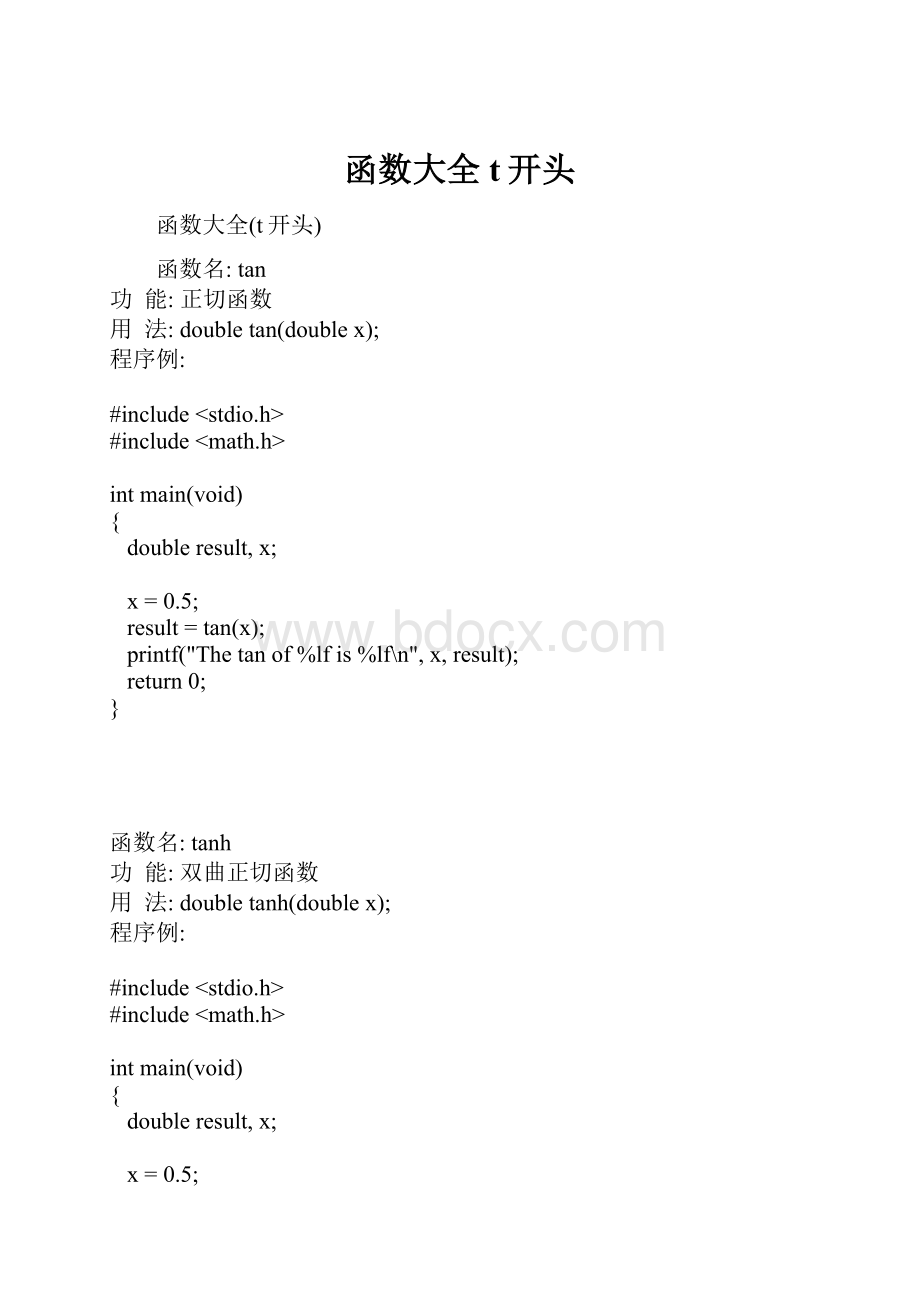函数大全t开头.docx
《函数大全t开头.docx》由会员分享,可在线阅读,更多相关《函数大全t开头.docx(12页珍藏版)》请在冰豆网上搜索。

函数大全t开头
函数大全(t开头)
函数名:
tan
功 能:
正切函数
用 法:
double tan(double x);
程序例:
#include
#include
int main(void)
{
double result, x;
x = 0.5;
result = tan(x);
printf("The tan of %lf is %lf\n", x, result);
return 0;
}
函数名:
tanh
功 能:
双曲正切函数
用 法:
double tanh(double x);
程序例:
#include
#include
int main(void)
{
double result, x;
x = 0.5;
result = tanh(x);
printf("The hyperbolic tangent of %lf is %lf\n", x, result);
return 0;
}
函数名:
tell
功 能:
取文件指针的当前位置
用 法:
long tell(int handle);
程序例:
#include
#include
#include
#include
int main(void)
{
int handle;
char msg[] = "Hello world";
if ((handle = open("TEST.$$$", O_CREAT | O_TEXT | O_APPEND)) == -1)
{
perror("Error:
");
return 1;
}
write(handle, msg, strlen(msg));
printf("The file pointer is at byte %ld\n", tell(handle));
close(handle);
return 0;
}
函数名:
textattr
功 能:
设置文本属性
用 法:
void textattr(int attribute);
程序例:
#include
int main(void)
{
int i;
clrscr();
for (i=0; i<9; i++)
{
textattr(i + ((i+1) << 4));
cprintf("This is a test\r\n");
}
return 0;
}
函数名:
textbackground
功 能:
选择新的文本背景颜色
用 法:
void textbackground(int color);
程序例:
#include
int main(void)
{
int i, j;
clrscr();
for (i=0; i<9; i++)
{
for (j=0; j<80; j++)
cprintf("C");
cprintf("\r\n");
textcolor(i+1);
textbackground(i);
}
return 0;
}
函数名:
textcolor
功 能:
在文本模式中选择新的字符颜色
用 法:
void textcolor(int color);
程序例:
#include
int main(void)
{
int i;
for (i=0; i<15; i++)
{
textcolor(i);
cprintf("Foreground Color\r\n");
}
return 0;
}
函数名:
textheight
功 能:
返回以像素为单位的字符串高度
用 法:
int far textheight(char far *textstring);
程序例:
#include
#include
#include
#include
int main(void)
{
/* request auto detection */
int gdriver = DETECT, gmode, errorcode;
int y = 0;
int i;
char msg[80];
/* initialize graphics and local variables */
initgraph(&gdriver, &gmode, "");
/* read result of initialization */
errorcode = graphresult();
if (errorcode !
= grOk) /* an error occurred */
{
printf("Graphics error:
%s\n", grapherrormsg(errorcode));
printf("Press any key to halt:
");
getch();
exit
(1); /* terminate with an error code */
}
/* draw some text on the screen */
for (i=1; i<11; i++)
{
/* select the text style, direction, and size */
settextstyle(TRIPLEX_FONT, HORIZ_DIR, i);
/* create a message string */
sprintf(msg, "Size:
%d", i);
/* output the message */
outtextxy(1, y, msg);
/* advance to the next text line */
y += textheight(msg);
}
/* clean up */
getch();
closegraph();
return 0;
}
函数名:
textmode
功 能:
将屏幕设置成文本模式
用 法:
void textmode(int mode);
程序例:
#include
int main(void)
{
textmode(BW40);
cprintf("ABC");
getch();
textmode(C40);
cprintf("ABC");
getch();
textmode(BW80);
cprintf("ABC");
getch();
textmode(C80);
cprintf("ABC");
getch();
textmode(MONO);
cprintf("ABC");
getch();
return 0;
}
函数名:
textwidth
功 能:
返回以像素为单位的字符串宽度
用 法:
int far textwidth(char far *textstring);
程序例:
#include
#include
#include
#include
int main(void)
{
/* request auto detection */
int gdriver = DETECT, gmode, errorcode;
int x = 0, y = 0;
int i;
char msg[80];
/* initialize graphics and local variables */
initgraph(&gdriver, &gmode, "");
/* read result of initialization */
errorcode = graphresult();
if (errorcode !
= grOk) /* an error occurred */
{
printf("Graphics error:
%s\n", grapherrormsg(errorcode));
printf("Press any key to halt:
");
getch();
exit
(1); /* terminate with an error code */
}
y = getmaxy() / 2;
settextjustify(LEFT_TEXT, CENTER_TEXT);
for (i=1; i<11; i++)
{
/* select the text style, direction, and size */
settextstyle(TRIPLEX_FONT, HORIZ_DIR, i);
/* create a message string */
sprintf(msg, "Size:
%d", i);
/* output the message */
outtextxy(x, y, msg);
/* advance to the end of the text */
x += textwidth(msg);
}
/* clean up */
getch();
closegraph();
return 0;
}
函数名:
time
功 能:
取一天的时间
用 法:
logn time(long *tloc);
程序例:
#include
#include
#include
int main(void)
{
time_t t;
t = time(NULL);
printf("The number of seconds since January 1, 1970 is %ld",t);
return 0;
}
函数名:
tmpfile
功 能:
以二进制方式打开暂存文件
用 法:
FILE *tmpfile(void);
程序例:
#include
#include
int main(void)
{
FILE *tempfp;
tempfp = tmpfile();
if (tempfp)
printf("Temporary file created\n");
else
{
printf("Unable to create temporary file\n");
exit
(1);
}
return 0;
}
函数名:
tmpnam
功 能:
创建一个唯一的文件名
用 法:
char *tmpnam(char *sptr);
程序例:
#include
int main(void)
{
char name[13];
tmpnam(name);
printf("Temporary name:
%s\n", name);
return 0;
}
函数名:
tolower
功 能:
把字符转换成小写字母
用 法:
int tolower(int c);
程序例:
#include
#include
#include
int main(void)
{
int length, i;
char *string = "THIS IS A STRING";
length = strlen(string);
for (i=0; i {
string[i] = tolower(string[i]);
}
printf("%s\n",string);
return 0;
}
函数名:
toupper
功 能:
把字符转换成大写字母
用 法:
int toupper(int c);
程序例:
#include
#include
#include
int main(void)
{
int length, i;
char *string = "this is a string";
length = strlen(string);
for (i=0; i {
string[i] = toupper(string[i]);
}
printf("%s\n",string);
return 0;
}
函数名:
tzset
功 能:
UNIX时间兼容函数
用 法:
void tzset(void);
程序例:
#include
#include
#include
int main(void)
{
time_t td;
putenv("TZ=PST8PDT");
tzset();
time(&td);
printf("Current time = %s\n", asctime(localtime(&td)));
return 0;
}